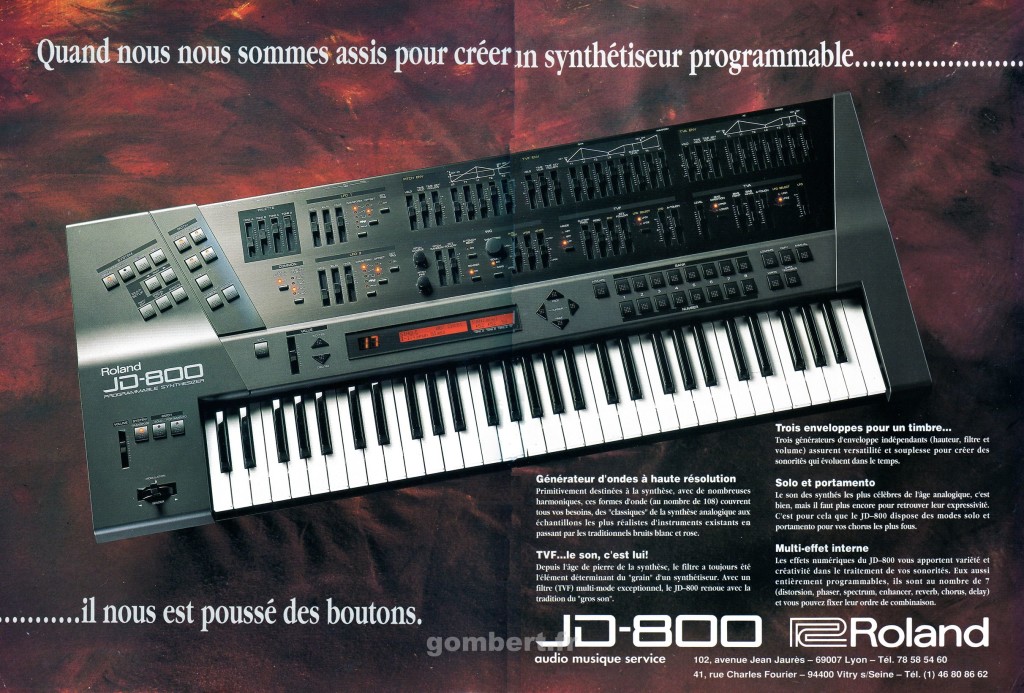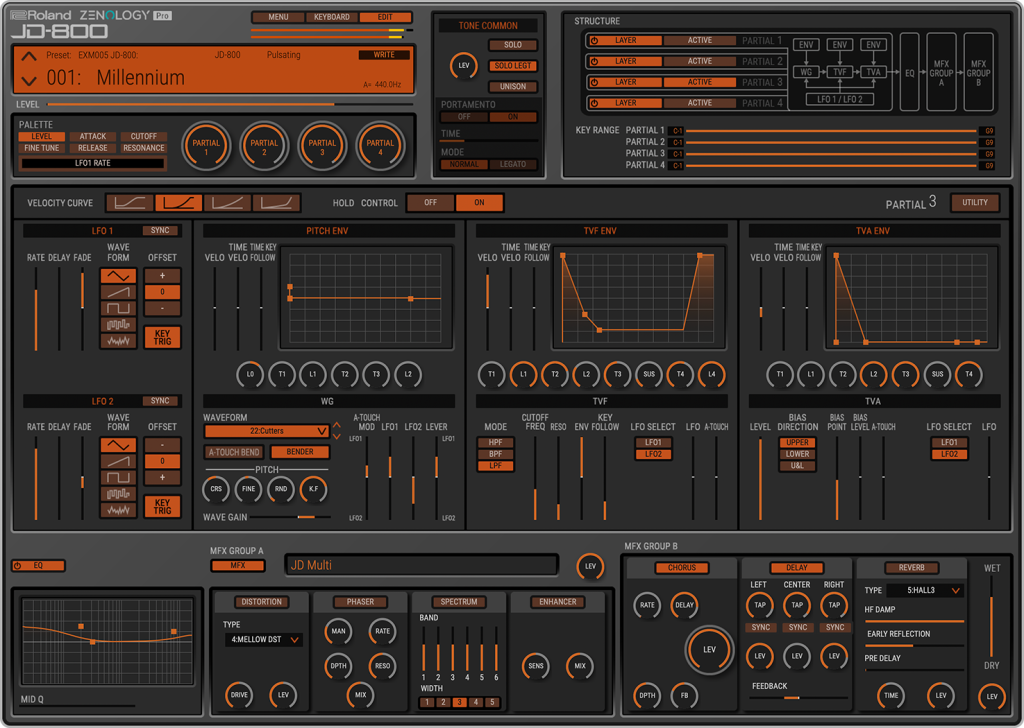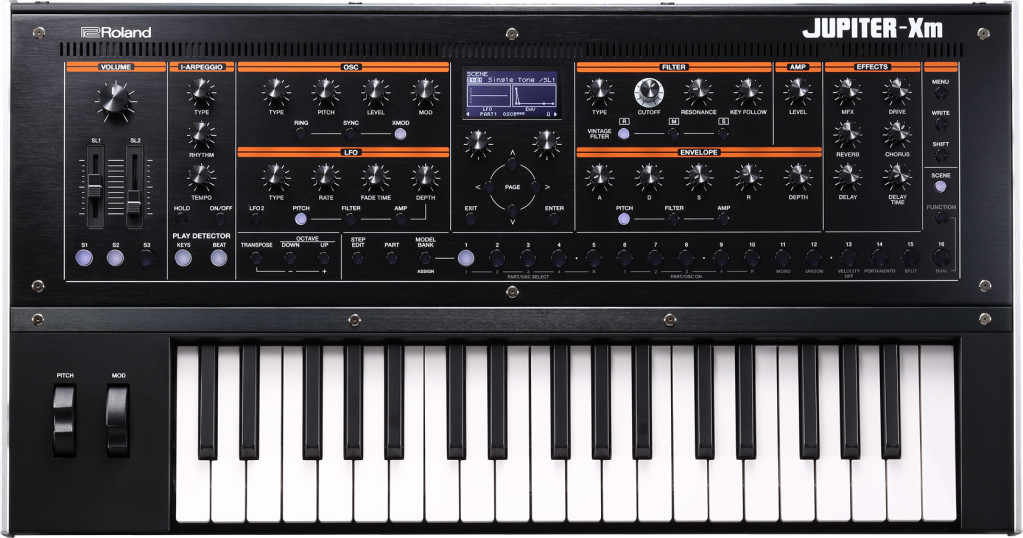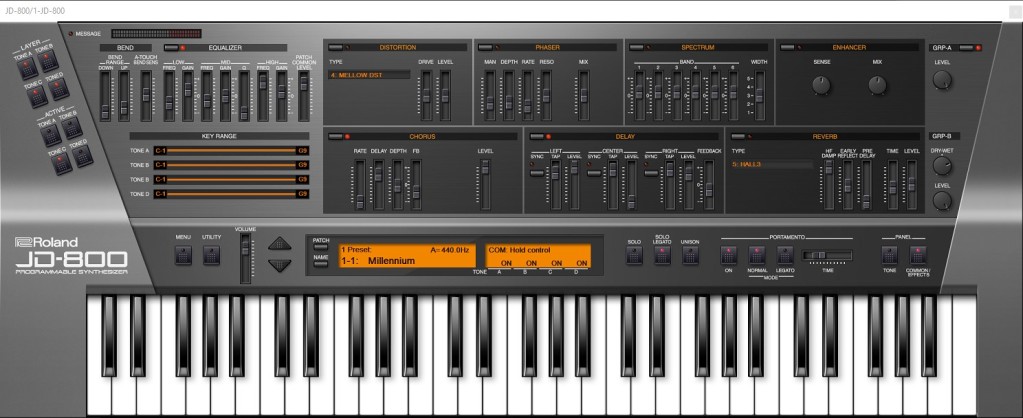Until recently, the only way to get your hands on a Roland JD-800 was to get the early-90s original hardware. But now Roland has this year unveiled two independent hardware and two independent software recreations. Let’s make sense of it all – and why it’s suddenly happening now.
I would say this isn’t déjà vu or a glitch in the matrix but – no, it totally is both those things. Suffice to say, the recent decision by Roland to announce four different JD-800 renditions on three separate launch dates is divisive. It’s split between the following reactions – one, “a JD what?“; two, “oh that old 90s crap?!”; three, “rejoice, and let us plot a chart through the 1990s to new cosmic levels of acid and trance on one of the greatest keyboards of all time?” I’ve also heard all the responses in between, including “I have human hands, how do you expect me to play a fader with a throw of 20 mm? Is this Boutique Series a product for mystical forest fairies?“
Last answer – yes, absolutely it is, and now they’re complaining to me about how they’re not really getting 256 steps of 78 micrometers each. But on to the rest…
JD-800: the early 1990s one
The JD-800. 1990s. While we are experiencing déjà vu, here’s an ad in French, apparently from:

In 1991, this was a big deal, because most manufacturers had hidden all the faders and knobs and buttons that would allow you to actually program them. You had to dial up a preset like “Millennium” and be stuck with it — unless you found a software editor/librarian or bought add-on controller hardware. The JD-800 was really the big-maker instrument that gave a glimpse to where we’d wind up now – ultimately, synthesists would find they loved mangling their own sound and moving faders and even screwing stuff up, rather than being limited to presets. And they love physical controls.
For more retro action, Retro Synth Ads has us covered.)
If you do have the original hardware, it’s well-supported by a passionate community – with editor/librarian software (useful even with all those-controls, because it’s so deep), preset libraries, and lavish coverage.
The JD-800 wasn’t cheap when it came out, in contrast to today’s eminently affordable gear. So that means a lot of folks haven’t ever used one in person – though extensive use by folks like The Prodigy will surely help Roland sell people on it now. And it’s safe to say that the JD-800 gets muddled with the D-50 – fair, as the architecture is related (including the combination of simulated virtual analog subtractive with PCM waveforms). But the JD-800 adds major changes, like multimode filters, and more capabilities, in addition to more physical access. I think it’s also unfair that the JD-800 gets marked as dated 90s cheese, because once you get into the architecture, there’s a lot you can do with it that feels perfectly relevant now.
For some of that history, you can read on the Roland site:
Part of the credit for making the JD-800 so good goes to Roland’s Chief Sound Designer at the time, Eric Persing. At Roland, he oversaw both the JD-800 and D-50, plus the JX, JV, JP, and XP lines. But you might also know his name from the company he started afterwards, Spectrasonics, maker of Omnisphere, Atmosphere, and so on. Paul McCabe talks to Eric for Roland:
Digital Dreams: Eric Persing and the JD-800
And as for some of the music, I did some digging on that.
Honestly, what struck me is how great a lot of the music is, not just in a retro way – particularly King Britt’s superb Scuba project. So anyone whining about synths – use your ears instead; this sure inspires me to get playing and creating.
JD-800: the 2021 versions
The nice thing about all these recreations is, you can now get a JD-800 in a way that’s cheap and modern. The question is – how, exactly. Roland announced the return of the JD-800 in March, then announced the return of the JD-800 last month, now announced the return of the JD-800 again this week. What in the name of Ace Electronic is going on here?
Keeping in mind the JD-800 was a 100% digital synth, there’s not much to “model” here. Basically, any one of these recreations just is a JD-800. Roland has access to all of the original architecture and waveforms and presets. The only limitations are down to whether they do something to restrict the original architecture (generally, they don’t) or add (they didn’t) and which soundbanks / presets they choose (ZENOLOGY has the most). But they’re not doing much beyond that, so this probably will come down to which interface you want and where you want to run your JD-800 (and how much you want to pay for it).
The different versions, which Roland themselves don’t explain terribly clearly, mean basically you get the JD-800 as:

A software plug-in with a new interface. The JD-800 Model Expansion for ZENOLOGY, available on Roland Cloud.
JD-800 running on JUPITER-X and JUPITER-Xm hardware. The JD-800 Model Expansion also runs on JUPITER-X/Xm, via Roland’s ZEN-Core technology.
A software plug-in with an interface that looks like the original hardware. This is the JD-800 plug-in recently announced for Roland Cloud.
Dedicated hardware. The JD-08 Boutique Series is basically a pint-sized JD-800 – the full engine and sound design features, but with a more limited interface. The upside? It runs on AA batteries or USB power, and it doesn’t take up much space, and it has a USB MIDI and audio interface. That’s not all true of either the modern JUPITER solution or the original.
Which do you use? Hardware, that’s simple. Software, it’s … a little more complicated.

Hardware. On hardware, this is an easy choice. If you want a full-sized keyboard instrument, you can choose either the JUPITER-X or JUPITER-Xm. (Make sure you have the latest firmware.) With that, you can run the JD-800 Model Expansion in both ZENOLOGY software and install it on your keyboard. Note that you do have to buy a lifetime key – sadly they didn’t make the subscriptions work with this (which raises a few eyebrows I’m sure). But if you can stomach that, the result is cool, in that your JUPITER just also became a JD-800 without having to go on eBay or Reverb.
Note, a big architectural difference here – ZEN-Core lets you swap presets between hardware and software, meaning you can move between ZENOLOGY plug-in and JUPITER hardware.
The Boutique JD-08 sadly does not. So you can’t move your presets from software onto the hardware, which is a huge downer on an architecture this deep.
Software. Software gets a little more confusing. From a sound perspective, I can’t find any difference between the JD-800 Model Expansion, which runs in ZENOLOGY and ZENOLOGY PRO, and the “JD-800” plug-in. You get different interfaces. The ZENOLOGY UI looks more modern, and it’s easier to see envelope shapes. The JD-800 plug-in’s skeumorphism is a little silly onscreen, but it’s also nice to understand the logic of the instrument from a recreation of its front panel. The ZENOLOGY UI is one-screen; the JD-800 has a switch to get into the effects panel – which makes the effects more roomy.

It really comes down to the hardware question again – and presets. There’s more sound content for the ZENOLOGY version, and it works with the JUPITER. The standalone JD-800 plug-in can be controlled by the Boutique JD-08, so it probably makes more sense if you own that hardware. You can’t exchange presets between the two versions, which is just annoying – but they’re evidently different architectures under the hood.
And if you do miss 1990s Roland – like the fact that they had a bunch of complicated tables – here’s a complicated table explaining compatibility of the Model Expansions.
(For even more complexity, the Zenbeats app for iOS also supports ZEN-Core, so as far as I know you should be able to export presets from the ZENOLOGY PRO plug-in and export them to your iPad or whatever, even if the app doesn’t directly support the Model Expansion, but I’ll check.)
It’s all too complicated, really. To me, the winner is simple, though – I like the JD-800 plug-in, and adding the Boutique hardware is both the most convenient and most economical solution for use with a computer (with the hardware as controller in combination with the mouse) or without (with the hardware as standalone in a mobile rig).
My advice if you want a JD-800: Get the plug-in; that’s possible with just the Pro subscription of US$99 / year. And get the Boutique if you want hardware. (You can even unlock the JD-800 that you can control with the Boutique with just the Pro subscription – using this thing called the Pro Access Selector…)
Why you’d do this
Just don’t think it’s all for 90s nostalgia here. There are some great features on the JD-800 for sound design:
- Rich, cutting PCM wavetables, 90s style – they don’t make ’em like this any more – combined with a reasonable virtual analog architecture and multimode filters
- Tons of distortion effects (I love “cry distortion,” for instance – again, really a Roland distortion algorithm sound)
- Easy sound shaping with the spectrum and layers
- Tons of multistage envelopes and a very layered architecture
- It’s still 44.1/16-bit, including the waveforms – so it can sound modern when you want it to
All of this is much, much easier to edit in software than even the original hardware. Don’t let the controls fool you – there was still a lot of menu diving. (The JD-800 plug-in even cheats, as it brings up a second panel that the original never had. Also, pop-up menus.)
The combination of biting, clean waveforms, rich pads, sound sculpting, and guitar-style distortion I think is kind of a winner even now.
But then, there are a lot of other instruments out there – including Eric’s latest. So it’s not for everyone, but that character and approach is unique and a product of its time.
For more –
The Prodigy covers this and other synths used by the band
Read a review of the original from Sound on Sound
And seriously, go check King’s Scuba project:
https://www.discogs.com/master/86867-King-Britt-Presents-Scuba-Hidden-Treasures